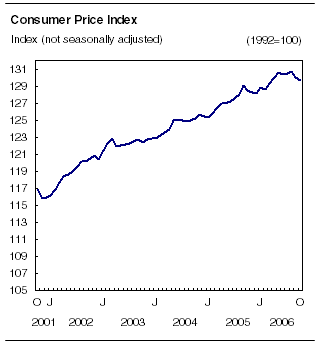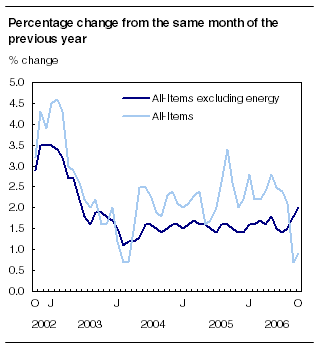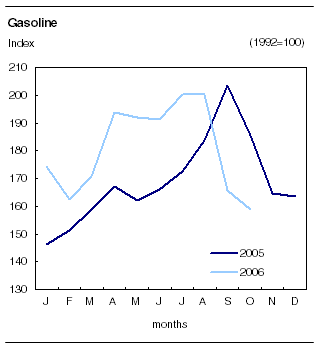Common menu bar links
Consumer Price Index
Archived Content
Information identified as archived is provided for reference, research or recordkeeping purposes. It is not subject to the Government of Canada Web Standards and has not been altered or updated since it was archived. Please "contact us" to request a format other than those available.

Lower gasoline prices mitigated the upward pressure on consumer prices, driven mainly by owned accommodation. However, excluding energy, the index climbed over the 2.0% threshold for the first time since June 2003.

The All-items Consumer Price Index (CPI) rose 0.9% between October 2005 and October 2006, a slight increase from the 0.7% advance recorded in the previous month. The 12-month change in the All-items index, having remained below the 1.0% mark for two months, continued to advance at a moderate pace.
The All-items index excluding energy posted a 2.0% increase between October 2005 and October 2006, rising for the second consecutive month. Costs incurred by homeowners, such as replacement cost and mortgage interest cost, were largely responsible for the upswing in this index.
As announced last month, Statistics Canada now produces and disseminates the Core Consumer Price Index as defined by the Bank of Canada. This index, used by the Bank for the purpose of monitoring the inflation-control target, rose by 2.3% between October 2005 and October 2006.
On a monthly basis, the All-items index fell for a second straight month. Consumer prices dropped 0.2% in October, following a decline of 0.5% in September. Once again, gasoline prices were a significant factor in the drop of the monthly CPI.
The All-items index excluding energy rose 0.2% in October, compared with 0.5% in September. Increased property taxes (including special fees) and higher mortgage interest costs were the main contributors to this increase.
The monthly Core CPI rose 0.1% in October.

Gasoline slows the rise in consumer prices
In October 2006, prices paid by consumers increased 0.9% from October 2005, a slight increase compared to the 0.7% growth recorded in the previous month.
Over the past two months, the rise in consumer prices has remained relatively weak. Not since March 2004 has there been two straight months where the 12-month change was below 1.0%.
Homeowners' replacement cost, which represents the worn-out structural portion of housing and is estimated using new housing prices (excluding land), rose by 8.8% between October 2005 and October 2006.
Increases in replacement cost varied widely from province to province in October. Alberta again stood out sharply with a large increase of 48.3%, while other provinces experienced relatively modest increases.
Mortgage interest cost, which measures changes in mortgage interest owed by consumers, rose 4.0% between October 2005 and October 2006. This was the largest 12-month increase since May 2001.
Electricity prices rose 6.9% between October 2005 and October 2006, contributing again to the rise in the All-items index.
Downward pressure came from a decrease in fossil fuels prices, which mitigated the 12-month increase in the October All-items CPI.
In October 2006, consumers paid 14.3% less for gasoline than they did in October 2005. This follows the 12-month drop of 18.7% in September.

The natural gas index fell 16.4% between October 2005 and October 2006. Alberta (-37.7%) and Ontario (-9.7%) posted the most substantial reductions. The increase in world natural gas stocks has reduced the price on world markets, holding it below the $5 US dollars per million BTU mark in recent months.
The 15.4% drop in the average price of heating oil and other fuels reflected price reductions in Quebec (-16.8%), Ontario (-12.0%) and Nova Scotia (-15.7%) between October 2005 and October 2006.
The price of computer equipment and supplies fell 19.9% between October 2005 and October 2006. While these durable goods are purchased only occasionally by consumers, they play an important role in reducing upward pressure on prices.
The Bank of Canada's Core Consumer Price Index increases
Statistics Canada now produces and disseminates the Core Consumer Price Index as defined by the Bank of Canada. This index is used by the Bank to guide monetary policy.
Although Statistics Canada will henceforth announce and publish the Core CPI, the underlying methodology for the index was established by the Bank of Canada and remains the latter's responsibility.
The measure of the Core CPI excludes from the All-items CPI the effect of the changes in indirect taxes and eight of the most volatile components identified by the Bank of Canada: fruit, fruit preparations and nuts; vegetables and vegetable preparations; mortgage interest cost; natural gas; fuel oil and other fuel; gasoline; inter-city transportation; and tobacco products and smokers' supplies.
The Core CPI as defined by the Bank of Canada was at 129.7 in October 2006.
The 12-month growth posted by this index was 2.3% between October 2005 and October 2006.
Gasoline and natural gas push down the monthly CPI
The 0.2% reduction in the All-items CPI between September and October 2006 was due primarily to lower fossil fuel prices.
In October 2006, the 4.0% reduction in the price of gasoline was the main source of the drop in the monthly index. New Brunswick (-10.1%) posted the largest decline in gasoline prices in October, while Ontario (-1.8%) posted the smallest.
The monthly change in natural gas, which fell 11.4% in October 2006, was also a significant factor in the downward movement of the All-items CPI. This change was driven by the 30.3% reduction in prices in Alberta, a reversal from the previous month when the price of natural gas rose 31.9%.
Changes in property taxes (including special fees) are reflected in the CPI once a year, in October. This year, property taxes were up 3.0%, compared with an increase of 3.2% in October 2005. After rising steadily between 2000 and 2004, the growth in average property taxes has slowed over the past two years.
Except for residents of Newfoundland and Labrador (+0.5%) and British Columbia (+0.4%), those in other provinces saw more substantial increases in their property taxes, although with a large variation across provinces. Residents of Prince Edward Island (+7.0%) experienced the sharpest increase in the country, followed at some distance by those in New Brunswick (+5.6%), Nova Scotia (+4.9%) and Saskatchewan (+4.3%). The increases noted by residents of Alberta (+3.7%), Ontario (+3.4%), Quebec (+3.0%) and Manitoba (+2.6%) were moderately rapid.
Consumers had to pay slightly more for fresh vegetables (+7.4%) between September and October 2006. Vegetable prices normally increase in October because of seasonal effects marking the end of the harvest period for locally-grown vegetables.
The mortgage interest cost rose by 0.6% in October 2006. This was the fourth straight month that there has been an increase in this index equal to or greater than 0.6%.
Available on CANSIM: tables 326-0001, 326-0002, 326-0009, 326-0012 and 326-0016 to 326-0018.
Definitions, data sources and methods: survey number 2301.
More information about the concepts and use of the CPI are also available online in Your Guide to the Consumer Price Index (62-557-XIB, free) from the Publications module of our website.
Available at 7 a.m. online under The Daily module of our website.
The October 2006 issue of the Consumer Price Index, Vol. 85, no. 10 (62-001-XIB, free) is now available from the Publications module of our website. A paper copy is also available (62-001-XPB, $12/$111). A more detailed analysis of the CPI is available in this publication.
The November Consumer Price Index will be released on December 19.
For more information or to enquire about the concepts, methods or data quality of this release, call Client Services (toll-free 1-866-230-2248; 613-951-9606; fax: 613-951-1539; prices-prix@statcan.gc.ca), Prices Division.


 Table(s).
Table(s).